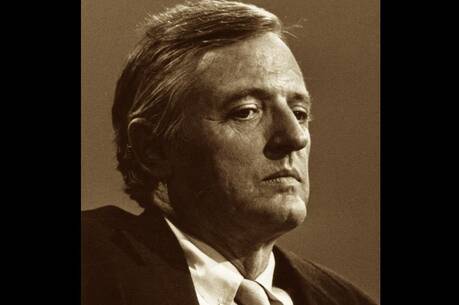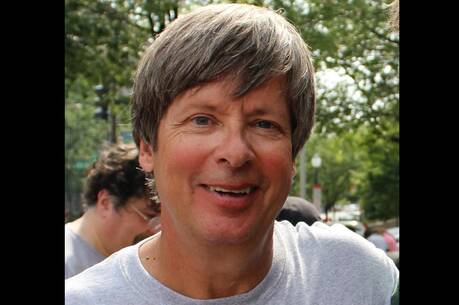
Fiction as a business—with a Catholic subtext
Rust Hills, Esquire’s longtime fiction editor, once had an ambitious and provocative idea: capture the most influential people in writing and publishing in a single graphic. The July 1963 issue of Esquire includes “The Structure of the American Literary Establishment,” a multi-colored chart containing “virtually everyone of any serious literary consequence… [in] the cultural-social-commercial situation which produces, promotes and evaluates literary writers.”
The document is a snapshot of literary power in the early 60s. There’s “The Cool World”: Grove Press, The Village Voice and bookstores like City Lights and Gotham Book Mart. There is a breakdown of influential professors and a round-up of academic and working critics. There are sections for book publishers, commercial magazines and for those who belonged in “Squaresville,” which ruffled The New York Times; the paper’s book review traded some barbs with Hills. Esquire color-coded the chart, including a red-hot center that contains Flannery O’Connor, James Baldwin, some then-stellar agents and more.
In the 1970s, editors "watched their power wane” as literary agents and marketing departments rose in stature and influence.
Big Fiction, the second book by Emory University professor Dan Sinykin, feels like a book-length treatment of Hills’s vision. Rather than capturing the pulse of a single literary moment, Sinykin manages to deconstruct the American publishing scene from 1960 to the present. The result is a book full of cogent analysis, ambitious argument, juicy quotes from insiders and a demonstration of the central role of Catholics in American publishing.
To be certain, Catholicism is not explicit in Sinykin’s analysis. Big Fiction is about conglomeration, a process that Sinykin sees as starting in 1960 when a newspaper company, Times Mirror, bought the New American Library. That same year, Random House channeled its “influx of cash” from going public to purchase Knopf. From then on, mergers and acquisitions became common practice in the industry. On such matters, Sinykin takes the approach of a literary historian: “This book defers judgment about whether conglomeration was good or bad in an effort to explain what it has meant for U.S. fiction and how we should read it.”
The book opens with Random House’s 1990 firing of André Schiffrin, a longtime editor—a framing that feels contemporary, as the publisher made waves with the departure of legendary editors in 2023 after layoffs and buyouts.
Sinykin has a knack for capturing the genesis of publishing trends while not attempting to make his argument too neat. “Editors,” he writes, “had once been the uncontested suzerains of title acquisition. Their tastes drove lists, front and back.” Yet in the 1970s, “they watched their power wane” as literary agents and marketing departments rose in stature and influence. Conglomeration led to editors being “more managerial, less editorial.”
In 1980, the novelist E.L. Doctorow testified at a Senate hearing on other results of conglomeration: “Traditionally a publishing list has always reflected the tension between the need to make money and the desire to publish well...[but] this delicate balance of pressures within a publishing firm is upset by the conglomerate [that] values the need for greater profits.” A decade later, Simon & Schuster president Richard Snyder would prove Doctorow correct, writing, “We are not a publisher, we are now a creator of copyrights for their exploitation in any medium or distribution system.”
Sinykin demonstrates how conglomeration has not only changed how publishers envision their business but also the type of writing that gets printed and championed.
Sinykin demonstrates how conglomeration has not only changed how publishers envision their business but also the type of writing that gets printed and championed. He considers the rise of autofiction “the latest name for a long-standing novelistic practice in which the author uses their own life transparently as the source of their story.” Novelists like Rachel Cusk, Sally Rooney and Karl Ove Knausgård invent “a fictional avatar through whom the author can submit the literary world to their (hopefully) penetrating scrutiny.”
Sinykin deftly observes how autofiction is the “perfect form for conglomerate marketing,” as the genre “amplifies the romantic myth of the author.” The writer thus becomes “a walking, talking advertisement” while simultaneously “shedding control over her image and her work, making her at once more useful and more disposable.”
Such sharp observations about conglomeration and its discontents fill the book, yet it is the Catholic subtext of Big Fiction that feels especially fascinating and fresh. It begins early in the book when Sinykin shares an anecdote from the memoir Making of a Publisher by Victor Weybright, the editor of pulp writer Mickey Spillane. Weybright described Spillane as “an Old Testament writer inspired by his faith as a member of Jehovah’s Witnesses.” Spillane and other writers of “widely available paperbound books,” including Erskine Caldwell and Kathleen Winsor, “were under attack by the Catholics.” Sinykin notes that the Philadelphia Police Department’s vice squad had seized books by Caldwell and other New American Library authors in 1948.
Weybright, convinced that Catholic sensibilities were behind the censorship, hatched a plan: He “invited a handful of literary Catholic priests” to a cocktail party in New York City. Spillane and the priests moved away from the crowd and “engaged in theological debate.” Ready for battle, Spillane came armed with religious tracts, “defying [the priests] to produce Biblical justification of purgatory.” It seemed to work. “After that,” Weybright notes, “there was no sustained religious or social criticism of Mickey Spillane or his work.”
The Catholic presence in American publishing would soon become less reactionary. In 1953, the publisher Farrar, Straus & Young merged with Pellegrini & Cudahy. Sheila Cudahy became a partner, and FSC was born. Cudahy, a Catholic poet and translator, was a correspondent of Thomas Merton. Merton came over to the publisher along with his editor, the Jesuit-educated Robert Giroux. Giroux eventually became a partner (thus forming the present moniker of FSG) and used his position to champion Catholic writers: Merton, Flannery O’Connor, John Berryman, Jack Kerouac, Katherine Anne Porter, Donald Barthelme and Walker Percy.
Cormac McCarthy remained “poor and mostly unknown” into the late ‘80s, with his novels never selling more than 2,500 copies in hardcover.
While other Catholic anecdotes are curious—how the novelist Danielle Steel rendered a conversation in her novel The Promise after her own youthful desire to become a nun—the most salient are the professional trajectories of two novelists, one a cradle Catholic, the other a convert.
Cormac McCarthy, graduate of Knoxville Catholic High School and parishioner of Immaculate Conception Church, which was immortalized in his novel Suttree, benefited from the generous patronage of editor Albert R. Erskine. Erskine accepted McCarthy’s unsolicited manuscript, The Orchard Keeper, for publication in 1965. As Sinykin notes, despite “Erskine’s best efforts at promotion,” McCarthy’s books maintained only “a small regional audience.”
Within a decade, McCarthy’s novels went out of print, yet Erskine remained in his corner and “continued to use his connections to help McCarthy acquire grants to live on.” McCarthy continued to write and publish, but he remained “poor and mostly unknown” into the late ‘80s, with his novels never selling more than 2,500 copies in hardcover.
Other writers would have been cast aside, but McCarthy benefited from second and third chances. When Erskine retired in 1987, Sinykin describes how McCarthy had to finally find an agent. His query letter is as humorous as it is blunt: “I’ve never had an agent before, but I’m thinking now of getting one, and if you’re interested in talking to me, please call me before noon Rocky Mountain time at this phone number.” McCarthy signed with Amanda Urban, who partnered with his new editors to help nudge the novelist toward a broader market.
It worked. “McCarthy’s style changed,” Sinykin writes. “He adopted genre techniques that would persist in his work until the present,” trading “his earlier difficult prose and his picaresque, arguably shapeless plots” for “the popular voice of the Western — though not without losing McCarthy’s distinctive voice.” More readers discovered and appreciated McCarthy, but Sinykin argues that his artistic transition resulted from business pressures. In the past, “boutique novelists” could survive on poor sales, but new leadership “demanded each book support itself.” Conglomeration, Sinykin concludes, “made McCarthy middlebrow.”
Toni Morrison writes of broken Black bodies in an incarnational manner; of enslaved persons finding hope in the spiritual and the supernatural.
McCarthy’s cradle Catholicism translated to prose that felt syntactically derived from the rhythms of the Latin Mass and his constant interest in grand scopes. Yet another American Catholic writer was making her mark in the publishing world with an even more religious identity. Toni Morrison entered publishing in 1967 as a textbook editor for a subsidiary of Random House. Her first novel, The Bluest Eye, was released in 1970 with Holt, Rinehart. Sinykin describes what happened next: “When Robert Gottlieb, Knopf editor, learned that the author of The Bluest Eye worked in the same building, he brought her in house and became her editor for the rest of her life.”
Morrison resigned from Random House in 1983 and five years later published Beloved, her seminal work. The novel, Sinykin notes, “won the Pulitzer Prize in 1988, helped Morrison win the Nobel Prize in 1993, and has become the most widely-held U.S. novel in libraries and the most written-about U.S. novel in scholarly journals.” Morrison’s Catholicism is on full display in the novel, a postmodern work of historical fiction and horror. She writes of broken Black bodies in an incarnational manner; of enslaved persons finding hope in the spiritual and the supernatural.
Sinykin has a refreshing reading of both Beloved and Morrison’s identity. He calls the novel “terrifying and beautiful.” Beloved, Sinykin argues, “does everything,” which includes its ability to “allegorize the publishing industry for a Black woman who worked as an editor at a major house for sixteen years, who fought for Black writers in a sea of whiteness, who was more or less accused by other Black editors of being a race traitor.” He continues later in the book: “By placing Black women and their embodied experience at the center of her account, she overwhelms the arid institutionalism and racist epistemology of schoolteacher, and thus of conglomeration.”
Sinykin writes about Catholic authors without examining their Catholicism, which is not a criticism. The Catholic subtext of the book ironically affirms the ubiquity of Catholicism in publishing far beyond McCarthy and Morrison. Sinykin writes of the significance of Catholic writer Jay McInerney’s debut novel appearing in paperback and of the expansive career of Gerald Howard, who published fellow Catholic Don DeLillo. Still, McCarthy and Morrison offer the most enticing test cases.
In Big Fiction, Sinykin illuminates how two very different Catholics were both shaped by—and helped transform—American publishing.









